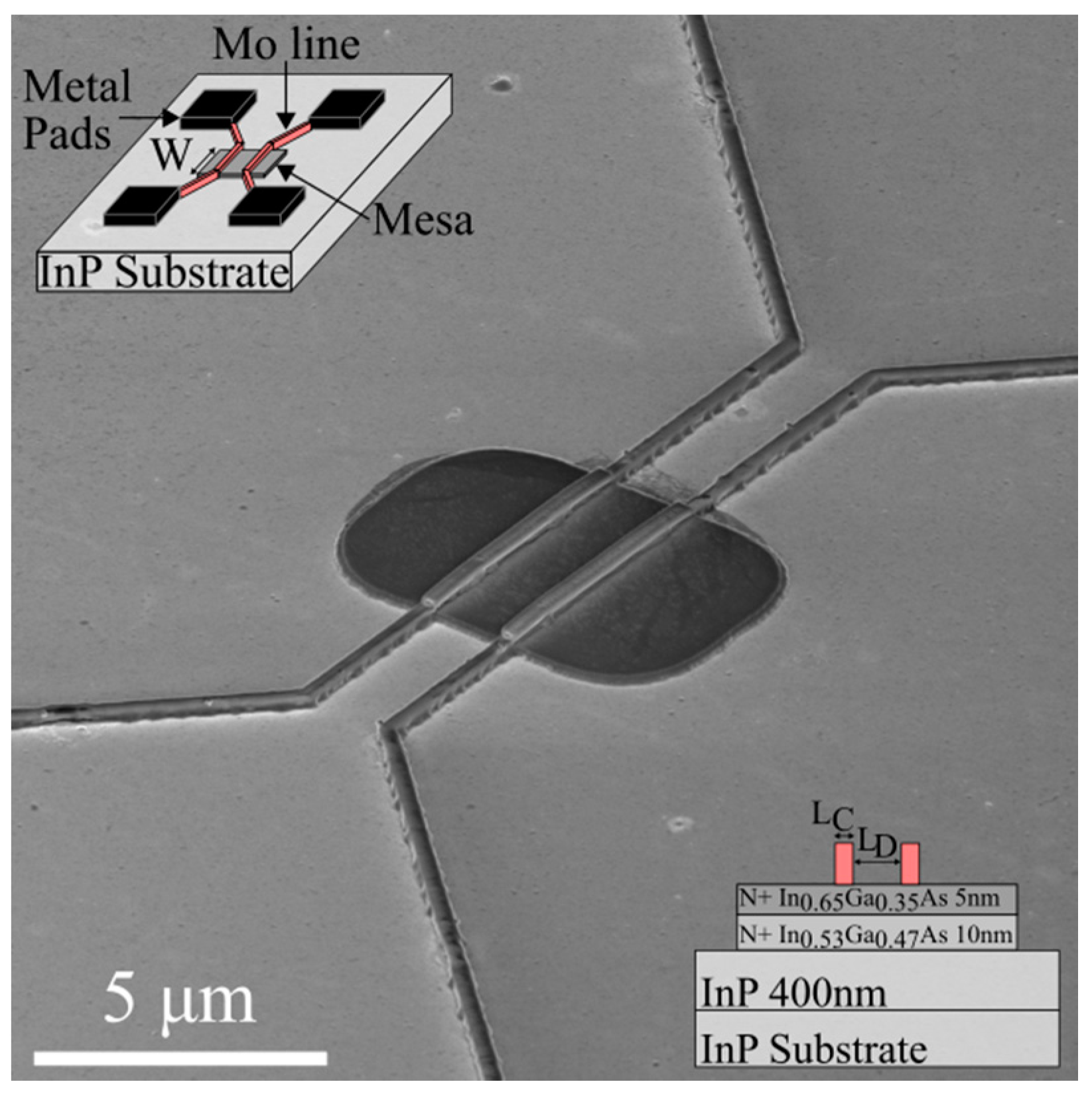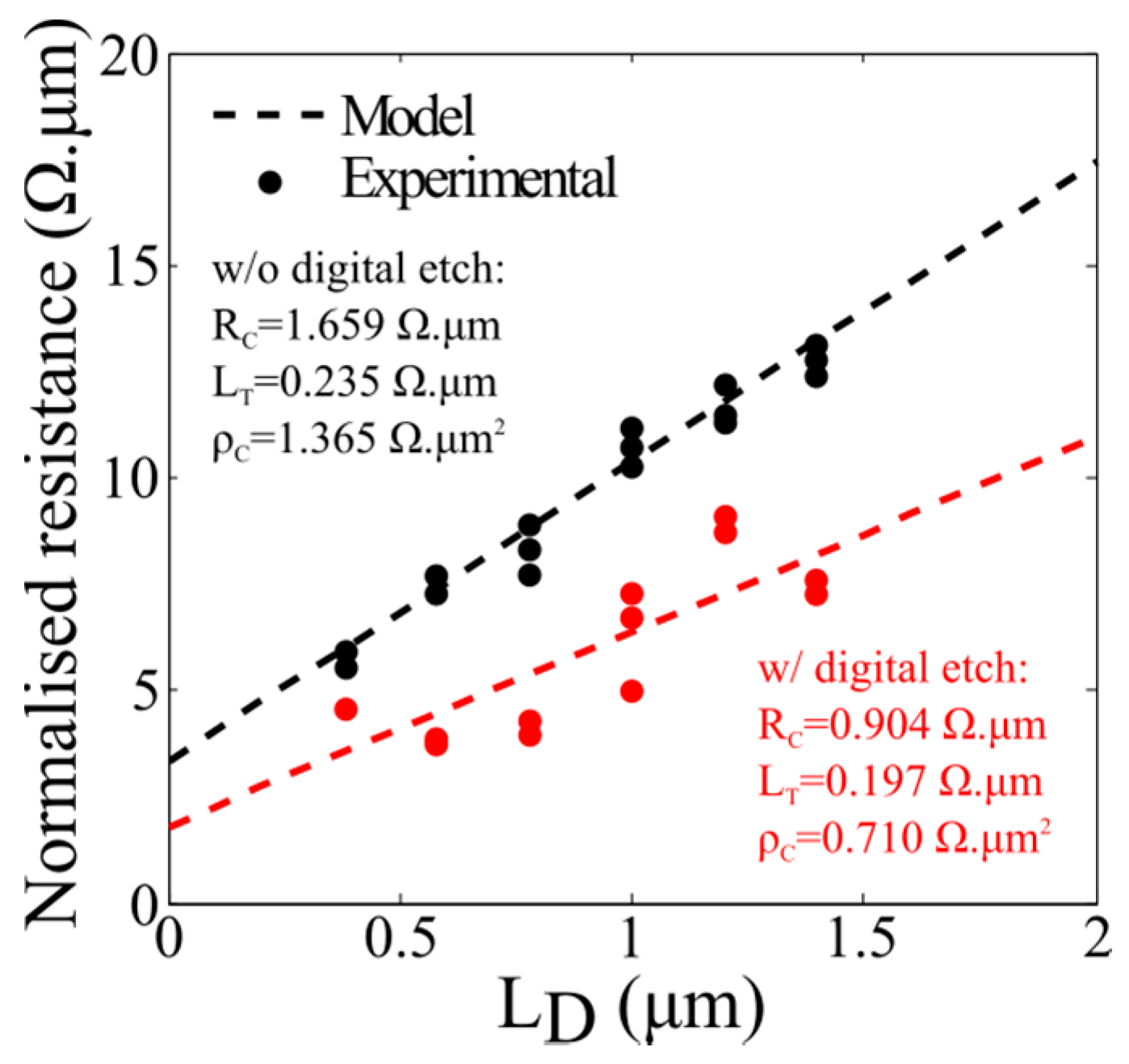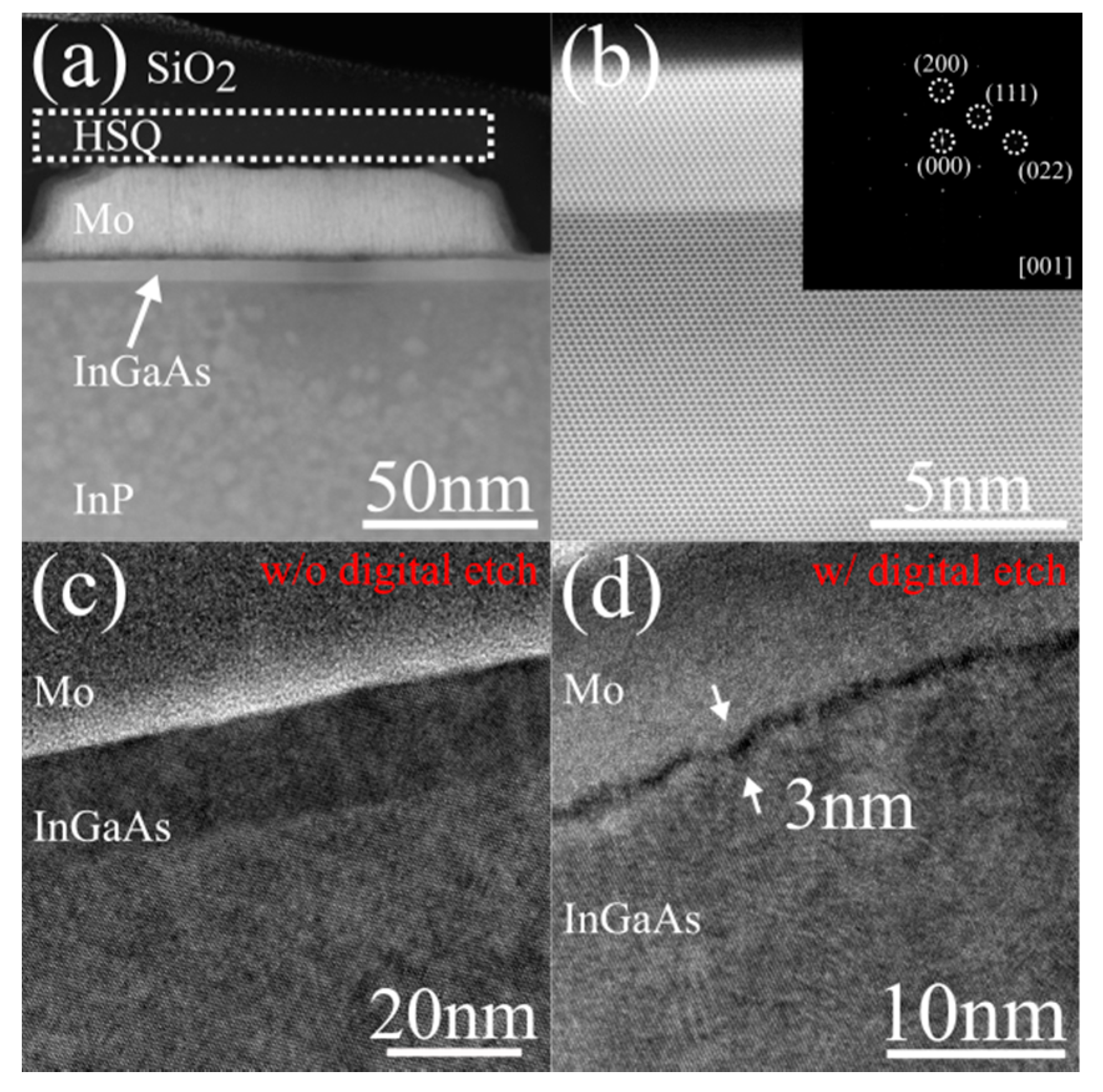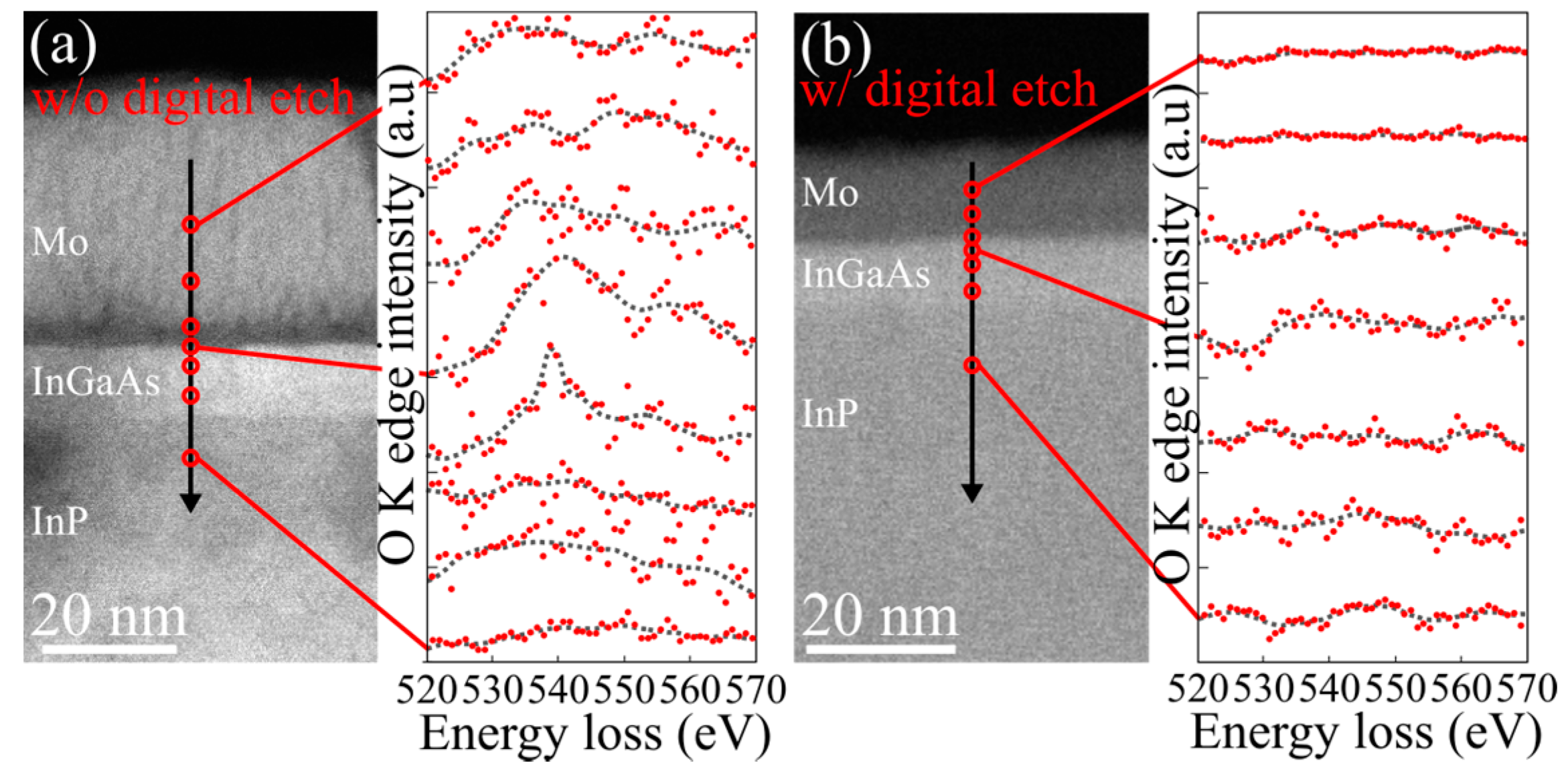The Role of III-V Substrate Roughness and Deoxidation Induced by Digital Etch in Achieving Low Resistance Metal Contacts
Abstract
:1. Introduction
2. Materials and Methods
3. Results and Discussion
3.1. Resistivity
3.2. Device Conformity
3.3. Interface Probing
4. Conclusions
Acknowledgments
Author Contributions
Conflicts of Interest
References
- Skotnicki, T.; Hutchby, J.A.; King, T.; Wong, H.S.P.; Boeuf, F. The end of CMOS scaling : Toward the introduction of new materials and structural changes to improve MOSFET performance. IEEE Circuits Devices Mag. 2005, 21, 16–26. [Google Scholar] [CrossRef]
- Del Alamo, J.A. Nanometre-scale electronics with III-V compound semiconductors. Nature 2011, 479, 317–323. [Google Scholar] [CrossRef] [PubMed]
- Hu, C.Y.; Hashizume, T.; Ohi, K.; Tajima, M. Trapping effect evaluation of gateless AlGaN/GaN heterojunction field-effect transistors using transmission-line-model method. Appl. Phys. Lett. 2010, 97, 222103. [Google Scholar] [CrossRef]
- Kim, S.H.; Yokoyama, M.; Taoka, N.; Iida, R.; Lee, S.; Nakane, R.; Urabe, Y.; Miyata, N.; Yasuda, T.; Yamada, H.; et al. Self-aligned metal source/drain InxGa1-xAs n-MOSFETs using Ni-InGaAs alloy. In Proceedings of the IEEE International Electron Devices Meeting (IEDM), San Francisco, CA, USA, 6–8 December 2010; pp. 596–599. [Google Scholar]
- Zhang, X.; Guo, H.; Ko, C.H.; Wann, C.H.; Cheng, C.C.; Lin, H.Y.; Chin, H.C.; Gong, X.; Lim, P.S.Y.; Luo, G.L.; et al. III-V MOSFETs with a new self-aligned contact. In Proceedings of the 2010 Symposium on VLSI Technology, Honolulu, HI, USA, 15–17 June 2010; pp. 233–234. [Google Scholar]
- Yuan, Z.; Kumar, A.; Chen, C.Y.; Nainani, A.; Bennett, B.R.; Boos, J.B.; Saraswat, K.C. Antimonide-Based Heterostructure p-Channel MOSFETs with Ni-Alloy Source/Drain. IEEE Electron Device Lett. 2013, 34, 1367–1369. [Google Scholar] [CrossRef]
- Zhang, X.; Guo, H.X.; Zhu, Z.; Gong, X.; Yeo, Y.C. In0.53Ga0.47As FinFETs with self-aligned molybdenum contacts and HfO2/Al2O3 gate dielectric. Solid State Electron. 2013, 84, 83–89. [Google Scholar] [CrossRef]
- Lee, R.T.P.; Loh, W.Y.; Tieckelmann, R.; Orzali, T.; Huffman, C.; Vert, A.; Huang, G.; Kelman, M.; Karim, Z.; Hobbs, C.; et al. Technology Options to Reduce Contact Resistance in Nanoscale III-V MOSFETs. ECS Trans. 2015, 66, 125–134. [Google Scholar] [CrossRef]
- Liao, M.H.; Chen, P.K. Experimental demonstration on the ultra-low source/drain resistance by metal-insulator-semiconductor contact structure in In0.53Ga0.47As field-effect transistors. AIP Adv. 2013, 3, 092118. [Google Scholar] [CrossRef]
- Law, J.J.M.; Carter, A.D.; Lee, S.; Huang, C.Y.; Lub, H.; Rodwell, M.J.W.; Gossard, A.C. Co-doping of InxGa1-xAs with silicon and tellurium for improved ultra-low contact resistance. J. Cryst. Growth 2013, 378, 92–95. [Google Scholar] [CrossRef]
- Jones, K.S.; Lind, A.G.; Hatem, C.; Moffatt, S.; Ridgeway, M.C. A Brief Review of Doping Issues in III-V Semiconductors. ECS Trans. 2013, 53, 97–105. [Google Scholar] [CrossRef]
- Barnett, J.; Hill, R.; Loh, W.Y.; Hobbs, C.; Majhi, P.; Jammy, R. Advanced techniques for achieving ultra-shallow junctions in future CMOS devices. In Proceedings of the 2010 International Workshop on Junction Technology, Shanghai, China, 10–11 May 2010; pp. 1–4. [Google Scholar]
- Orzali, T.; Vert, A.; Lee, R.T.P.; Norvilas, A.; Huang, G.; Herman, J.L.; Hill, R.J.W.; Papa Rao, S.S. Heavily tellurium doped n-type InGaAs grown by MOCVD on 300 mm Si wafers. J. Cryst. Growth 2007, 426, 243–247. [Google Scholar] [CrossRef]
- Athavalea, S.D.; Economoub, D.J. Realization of atomic layer etching of silicon. J. Vac. Sci. Technol. B 1996, 14, 3702–3805. [Google Scholar] [CrossRef]
- Ko, K.K.; Pang, S.W. Controllable layer-by-layer etching of III–V compound semiconductors with an electron cyclotron resonance source. J. Vac. Sci. Technol. B 1993, 11, 2275–2279. [Google Scholar] [CrossRef]
- Lin, J.; Zhao, X.; Yu, T.; Antoniadis, D.A.; del Alamo, J.A. A new self-aligned quantum-well MOSFET architecture fabricated by a scalable tight pitch process. In Proceedings of the 2013 IEEE International Electron Devices Meeting (IEDM), Washington, DC, USA, 9–11 December 2013; pp. 421–424. [Google Scholar]
- DeSalvo, G.C.; Bozada, C.A.; Ebel, J.L.; Look, D.C.; Barrette, J.P.; Cerny, C.L.A.; Dettmer, R.W.; Gillespie, J.K.; Havasy, C.K.; Jenkins, T.J.; et al. Wet Chemical Digital Etching of GaAs at Room Temperature. J. Electrochem. Soc. 1996, 143, 3652–3656. [Google Scholar] [CrossRef]
- Alian, A.; Merckling, C.; Brammertz, G.; Meuris, M.; Heyns, M.; De Meyer, K. InGaAs MOS transistors fabricated through a digital-etch gate-recess process and the influence of forming gas anneal on their electrical behavior. ECS J. Solid State Sci. Technol. 2012, 6, 310–314. [Google Scholar] [CrossRef]
- Lin, J.; Zhao, X.; Antoniadis, D.A.; del Alamo, J.A. A Novel Digital Etch Technique for Deeply Scaled III-V MOSFETs. IEEE Electron Device Lett. 2014, 35, 440–442. [Google Scholar] [CrossRef]
- Rajput, N.S.; Kim, S.G.; Chou, J.B.; Abed, J.; Viegas, J.; Jouiad, M. Electron beam induced rapid crystallization of water splitting nanostructures. MRS Adv. 2015, 1, 825–830. [Google Scholar] [CrossRef]
- Ravaux, F.; Alnuaimi, K.S.; Jouiad, M.; Saadat, I. Characterization of metal contact to III–V materials (Mo/InGaAs). Microelectron. Eng. 2015, 145, 1–4. [Google Scholar] [CrossRef]
- Lu, W.; Guo, A.; Vardi, A.; del Alamo, J.A. A Test Structure to Characterize Nano-Scale Ohmic Contacts in III-V MOSFETs. IEEE Electron Device Lett. 2014, 35, 178–180. [Google Scholar] [CrossRef]
- Buttari, D.; Heikman, S.; Keller, S.; Mishra, U.K. Digital Etching for Highly Reproducible Low Damage Gate Recessing on AlGaN/GaN HEMTs. In Proceedings of the 2002 IEEE Lester Eastman Conference, Newark, DE, USA, 8 August 2002; pp. 461–469. [Google Scholar]
- Muller, D.A.; Sorsch, T.; Moccio, S.; Baumann, F.H.; Evans-Lutterodt, K.; Timp, G. The electronic structure at the atomic scale of ultrathin gate oxides. Nature 1999, 399, 758–761. [Google Scholar] [CrossRef]
- Verleysen, E.; Bender, H.; Richard, O.; Schryvers, D.; Vandervorst, W. Characterization of nickel silicides using EELS-based methods. J. Microsc. 2010, 240, 75–82. [Google Scholar] [CrossRef] [PubMed]
- Hussey, R.J.; Sproule, G.I.; McCaffrey, J.P.; Graham, M.J. Characterization of Oxides Formed on InP, InGaAs, InAlAs, and InGaAs/InAlAs Heterostructures at 300–500 °C. Oxid. Met. 2002, 57, 427–447. [Google Scholar] [CrossRef]
- Brennan, B.; Hughes, G. Identification and thermal stability of the native oxides on InGaAs using synchrotron radiation based photoemission. J. Appl. Phys. 2010, 108, 053516. [Google Scholar] [CrossRef]




© 2017 by the authors. Licensee MDPI, Basel, Switzerland. This article is an open access article distributed under the terms and conditions of the Creative Commons Attribution (CC BY) license (http://creativecommons.org/licenses/by/4.0/).
Share and Cite
Ravaux, F.; Saadat, I.; Jouiad, M. The Role of III-V Substrate Roughness and Deoxidation Induced by Digital Etch in Achieving Low Resistance Metal Contacts. Crystals 2017, 7, 177. https://doi.org/10.3390/cryst7060177
Ravaux F, Saadat I, Jouiad M. The Role of III-V Substrate Roughness and Deoxidation Induced by Digital Etch in Achieving Low Resistance Metal Contacts. Crystals. 2017; 7(6):177. https://doi.org/10.3390/cryst7060177
Chicago/Turabian StyleRavaux, Florent, Irfan Saadat, and Mustapha Jouiad. 2017. "The Role of III-V Substrate Roughness and Deoxidation Induced by Digital Etch in Achieving Low Resistance Metal Contacts" Crystals 7, no. 6: 177. https://doi.org/10.3390/cryst7060177





